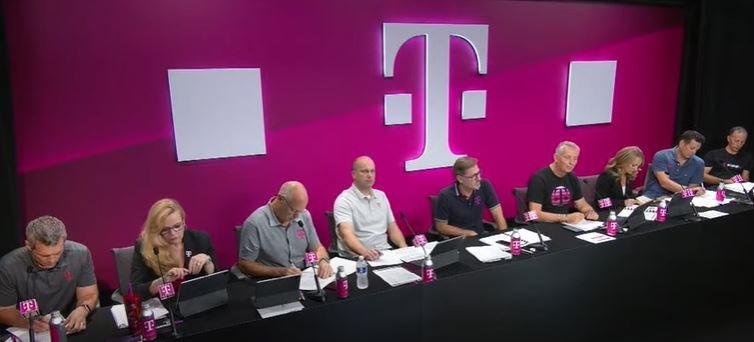A couple of years ago, T-Mobile shared its plan for building the best 5G network, offering the greatest value and increasing market share in areas where T-Mobile was massively under-penetrated relative to its peers.
That strategy is working better than ever, according to CEO Mike Sievert. T-Mobile added 760,000 postpaid phone customers in Q2 2023.
“In fact, T-Mobile delivered our highest Q2 postpaid phone net adds in eight years,” fueled by industry-leading gross adds and the lowest postpaid phone churn in company history, he said during Thursday’s earnings call.
During Q2, T-Mobile announced a new phone plan, Go5G Plus, which starts at $90 for a single line and targets consumers locked in a long-term contract with either of its two biggest rivals, but mostly AT&T. More than 60 percent of the accounts now joining T-Mobile are choosing to go with Go5G Plus, said Jon Freier, president of the Consumer Group. The “easy unlock” pitch and promise of getting a new device every two years are resonating with customers, he said.
Q2 service revenues of $15.7 billion grew 3% year-over-year and postpaid service revenues of $12.1 billion grew 5% year-over-year. Net income was $2.2 billion. Postpaid phone churn was 0.77%, a record low for the company.

Earlier this week, AT&T reported 326,000 postpaid phone net adds in Q2 2023 compared with 424,000 postpaid phone net adds in the first quarter of 2023. Verizon reported Q2 postpaid phone net additions of 8,000, comprised of 144,000 net adds from its Business group and 136,000 net losses from its Consumer group. That compares to the first quarter of 2023, when Verizon lost 127,000 postpaid phone customers.
Dealing with Dish
Asked about the spectrum option that Dish has to buy 800 MHz spectrum from T-Mobile, Sievert said T-Mobile did not object when Dish asked the Department of Justice (DoJ) for a 60-day extension to make a decision. The deadline now is August 11.
Through the deal the government set up to make Dish a No. 4 facilities-based carrier, Dish has the option to buy 800 MHz spectrum from T-Mobile for about $3.6 billion or not buy it and pay a penalty of $72 million to T-Mobile.
T-Mobile is now in discussions with Dish to see if there’s a “win-win” that might be different from Dish’s original DoJ deal, Sievert said, without going into detail. “If there is, that would be wonderful, but obviously, that deadline is coming so …Our view was it’s worth taking the extra time … in case there’s a bigger win-win to be had here,” he said.
That they’re in discussions about a mutual “win-win” is notable given their history. T-Mobile and Dish have not exactly seen eye to eye, so to speak, especially when Dish initially started using T-Mobile’s network under an MVNO arrangement. T-Mobile told Dish it was going to shut down the old Sprint CDMA network a lot sooner than Dish had anticipated, leading to all kinds of problems for Dish’s Boost Mobile customers.
The discussion about Dish sparked a question from analyst Craig Moffett of MoffettNathanson about whether T-Mobile would be interested in acquiring more mid-band spectrum if the opportunity presented itself, either from Dish or some other source.
Sievert replied that he didn’t mean to be flip, but “we’ve never met spectrum we didn’t like,” which would seem to apply to most U.S. wireless carriers. But one thing that distinguishes T-Mobile from other providers is “when we get our hands on spectrum, we put it to work, right away, for the benefit of the American consumer,” Sievert said.
That’s evident in the aggressive deployment of the 2.5 GHz spectrum that T-Mobile acquired as a result of the merger with Sprint. T-Mobile “built the best 5G network in history on that spectrum acquisition that came through the merger,” Sievert said. “We’re always on the hunt for other ways to add capacity,” including to meet the needs of fixed wireless access (FWA), aka high-speed internet (HSI) customers.
Slower FWA growth
During the second quarter, T-Mobile gained 509,000 FWA customers compared with the 523,000 net customer adds for the first quarter of 2023.
In comments following T-Mobile’s Q2 earnings announcement, Third Bridge analyst Jamie Lumley noted that fixed wireless/HSI growth continues to slow at T-Mobile. However, that’s likely due to the pacing of T-Mobile’s rollout rather than an indication of weakening demand, Lumley said.
Indeed, T-Mobile executives said churn is slowing in among its FWA customers, and Sievert made a point of noting that T-Mobile continues to approve who signs up for the service. T-Mobile only offers the FWA service to addresses where it has confirmed it has enough capacity. He reiterated that the company is on track to serve 7 million to 8 million FWA customers by 2025.
Cable
Cable in Q4 started to see some pretty big gains in wireless and even in a world where cable is taking share overall in postpaid, Sievert suggested it’s not impacting T-Mobile the same way it’s affecting others.
“We’re performing better than before they were in the industry, but obviously there’s a dynamic that affects others, both of our two look-alike competitors plus prepaid,” he said. “As you can see in our performance, it’s not affecting our results.”
Not surprisingly, T-Mobile raised its 2023 guidance, saying it now expects postpaid net customer additions to be between 5.6 million and 5.9 million, an increase from prior guidance of 5.3 million to 5.7 million. Core adjusted EBITDA is expected to be between $28.9 billion and $29.2 billion, an increase from prior guidance of $28.8 billion to $29.2 billion.

